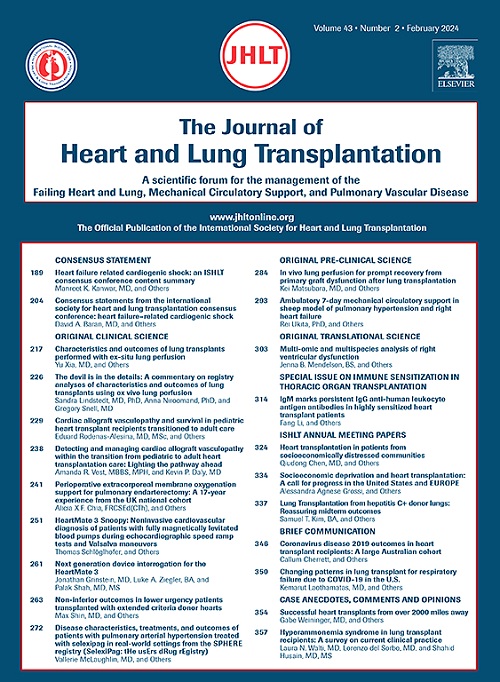Hospital volume does not mitigate the impact of area socioeconomic deprivation on heart transplantation outcomes
IF 6.4
1区 医学
Q1 CARDIAC & CARDIOVASCULAR SYSTEMS
引用次数: 0
Abstract
Background
While structural socioeconomic inequity has been linked with inferior health outcomes, some have postulated reduced access to high-quality care to be the mediator. We assessed whether treatment at high-volume centers (HVC) would mitigate the adverse impact of area deprivation on heart transplantation (HT) outcomes.
Methods
All HT recipients ≥18 years were identified in the 2005-2022 Organ Procurement and Transplantation Network. Neighborhood socioeconomic deprivation was assessed using the previously validated Area Deprivation Index. Recipients with scores in the highest quintile were considered Most Deprived (others: Less Deprived). Hospitals in the highest quartile by cumulative center volume (≥21 transplants/year) were classified as HVC. The primary outcome was post-transplant survival.
Results
Of 38,022 HT recipients, 7,579 (20%) were considered Most Deprived. Following risk adjustment, Most Deprived demonstrated inferior survival at 3 (hazard ratio [HR] 1.14, 95% confidence interval [CI] 1.06-1.21) and 5 years following transplantation (HR 1.13, CI 1.07-1.20). Similarly, Most Deprived faced greater graft failure at 3 (HR 1.14, CI 1.06-1.22) and 5 years (HR 1.13, CI 1.07-1.20).
Evaluating patients transplanted at HVC, Most Deprived continued to face greater mortality at 3 (HR 1.10, CI 1.01-1.21) and 5 years (HR 1.10, CI 1.01-1.19). The interaction between Most Deprived status and care at HVC was not significant, such that transplantation at HVC did not ameliorate the survival disparity between Most and Less Deprived.
Conclusions
Area socioeconomic disadvantage is independently associated with inferior survival. Transplantation at HVC did not eliminate this inequity. Future efforts are needed to increase engagement with longitudinal follow-up care and address systemic root causes to improve outcomes.
医院规模并不能减轻社会经济贫困地区对心脏移植结果的影响。
背景:虽然结构性社会经济不平等与较差的健康结果有关,但有些人认为获得高质量医疗服务的机会减少是中介因素。我们评估了在高容量中心(HVC)接受治疗是否会减轻地区贫困对心脏移植(HT)结果的不利影响:2005-2022年器官获取与移植网络中所有年龄≥18岁的心脏移植受者。使用先前验证的地区贫困指数评估邻近地区的社会经济贫困程度。得分在最高五分位数的受者被视为最贫困(其他:较不贫困)。按中心累计移植量(≥21 例/年)计算,处于最高五分位数的医院被归类为 HVC。主要结果是移植后存活率:在 38,022 例高密度脂蛋白受者中,7,579 例(20%)被认为是最贫困者。经过风险调整后,最贫困者在移植后 3 年(危险比 [HR] 1.14,95% 置信区间 [CI] 1.06-1.21)和 5 年(HR 1.13,CI 1.07-1.20)的存活率较低。同样,最贫困患者在移植后3年(HR 1.14,CI 1.06-1.22)和5年(HR 1.13,CI 1.07-1.20)面临的移植失败率更高。对在 HVC 进行移植的患者进行评估,最贫困患者在 3 年(HR 1.10,CI 1.01-1.21)和 5 年(HR 1.10,CI 1.01-1.19)后的死亡率仍然较高。最贫困状况与HVC护理之间的交互作用并不显著,因此在HVC进行移植并不能改善最贫困与较不贫困之间的存活率差异:结论:地区社会经济状况不佳与存活率较低密切相关。在 HVC 进行移植并不能消除这种不平等。今后需要努力提高纵向随访护理的参与度,并解决系统性的根本原因,以改善结果。
本文章由计算机程序翻译,如有差异,请以英文原文为准。
求助全文
约1分钟内获得全文
求助全文
来源期刊
CiteScore
10.10
自引率
6.70%
发文量
1667
审稿时长
69 days
期刊介绍:
The Journal of Heart and Lung Transplantation, the official publication of the International Society for Heart and Lung Transplantation, brings readers essential scholarly and timely information in the field of cardio-pulmonary transplantation, mechanical and biological support of the failing heart, advanced lung disease (including pulmonary vascular disease) and cell replacement therapy. Importantly, the journal also serves as a medium of communication of pre-clinical sciences in all these rapidly expanding areas.

 求助内容:
求助内容: 应助结果提醒方式:
应助结果提醒方式:


